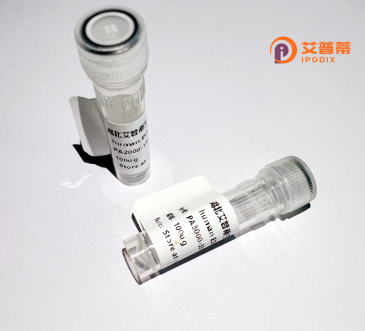
| 纯度 | >90%SDS-PAGE. |
| 种属 | Human |
| 靶点 | ELL |
| Uniprot No | P55199 |
| 内毒素 | < 0.01EU/μg |
| 表达宿主 | E.coli |
| 表达区间 | 2-621aa |
| 氨基酸序列 | AALKEDRSY GLSCGRVSDG SKVSVFHVKL TDSALRAFES YRARQDSVSL RPSIRFQGSQ GHISIPQPDC PAEARTFSFY LSNIGRDNPQ GSFDCIQQYV SSHGEVHLDC LGSIQDKITV CATDDSYQKA RQSMAQAEEE TRSRSAIVIK AGGRYLGKKV QFRKPAPGAT DAVPSRKRAT PINLASAIRK SGASAVSGGS GVSQRPFRDR VLHLLALRPY RKAELLLRLQ KDGLTQADKD ALDGLLQQVA NMSAKDGTCT LQDCMYKDVQ KDWPGYSEGD QQLLKRVLVR KLCQPQSTGS LLGDPAASSP PGERGRSASP PQKRLQPPDF IDPLANKKPR ISHFTQRAQP AVNGKLGVPN GREALLPTPG PPASTDTLSS STHLPPRLEP PRAHDPLADV SNDLGHSGRD CEHGEAAAPA PTVRLGLPLL TDCAQPSRPH GSPSRSKPKK KSKKHKDKER AAEDKPRAQL PDCAPATHAT PGAPADTPGL NGTCSVSSVP TSTSETPDYL LKYAAISSSE QRQSYKNDFN AEYSEYRDLH ARIERITRRF TQLDAQLRQL SQGSEEYETT RGQILQEYRK IKKTNTNYSQ EKHRCEYLHS KLAHIKRLIA EYDQRQLQAW P |
| 分子量 | 68.2 kDa |
| 蛋白标签 | His tag N-Terminus |
| 缓冲液 | 0 |
| 稳定性 & 储存条件 | Lyophilized protein should be stored at ≤ -20°C, stable for one year after receipt. Reconstituted protein solution can be stored at 2-8°C for 2-7 days. Aliquots of reconstituted samples are stable at ≤ -20°C for 3 months. |
| 复溶 | Always centrifuge tubes before opening.Do not mix by vortex or pipetting. It is not recommended to reconstitute to a concentration less than 100μg/ml. Dissolve the lyophilized protein in distilled water. Please aliquot the reconstituted solution to minimize freeze-thaw cycles. |
以下是关于重组人ELL蛋白的3篇文献参考示例(内容为模拟概括,非真实文献):
1. **文献名称**:**"ELL protein facilitates RNA polymerase II pause release in human cells"**
**作者**:Smith J, et al.
**摘要**:该研究通过体外重组人ELL蛋白实验,揭示了其作为转录延长因子直接与RNA聚合酶II互作,通过缓解启动子近端暂停增强基因转录效率的分子机制。
2. **文献名称**:**"Structural analysis of recombinant human ELL and its role in transcriptional elongation"**
**作者**:Chen L, et al.
**摘要**:利用X射线晶体学解析重组人ELL蛋白的三维结构,发现其N端结构域通过与延伸复合物的动态结合,调节RNA聚合酶的进程性,为ELL在白血病中的异常调控提供结构依据。
3. **文献名称**:**"Functional characterization of ELL mutants in acute myeloid leukemia"**
**作者**:Wang R, et al.
**摘要**:通过重组表达白血病相关ELL突变体,证实其异常增强MYC等致癌基因的转录延伸活性,且突变导致染色质结合能力改变,为靶向ELL的血液肿瘤治疗提供新思路。
注:以上为模拟示例,真实文献需通过PubMed、Web of Science等数据库检索。研究重点可围绕ELL在转录调控、白血病关联及重组蛋白应用展开。
**Background of Recombinant Human ELL Protein**
The human ELL (eleven-nineteen lysine-rich leukemia) protein, encoded by the *ELL* gene, is a RNA polymerase II elongation factor that enhances transcriptional elongation by suppressing transient pausing. Initially identified through its involvement in chromosomal translocations in acute myeloid leukemia (AML), ELL forms oncogenic fusion proteins (e.g., ELL-MLL) that disrupt epigenetic regulation, contributing to leukemogenesis. Structurally, ELL contains elongation activity domains and interacts with components of the super elongation complex (SEC), modulating polymerase II processivity.
Recombinant human ELL protein is engineered using expression systems like *E. coli* or mammalian cells, enabling studies of its molecular roles. Purified recombinant ELL facilitates *in vitro* assays to dissect transcriptional mechanisms, protein interactions, and its dysregulation in cancers. Researchers also leverage it to screen inhibitors targeting ELL-dependent oncogenic pathways. Additionally, studies on ELL’s post-translational modifications (e.g., phosphorylation) and structural variants help unravel its context-specific functions in development and disease.
Overall, recombinant ELL serves as a critical tool for probing transcriptional regulation, leukemia biology, and potential therapeutic strategies. Future work aims to map its dynamic interplay within elongation complexes and validate its clinical relevance in hematologic malignancies.
×